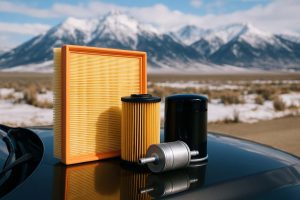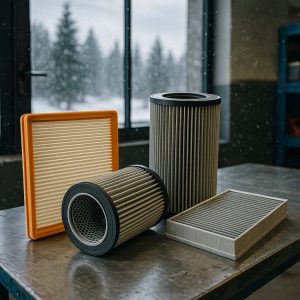When choosing filters for your car — air, oil, fuel, and cabin air — climate plays a more significant role than many drivers realize. From scorching heat to icy winters and dusty roads to high humidity, the conditions your vehicle operates in directly impact how your filters perform, how often they should be replaced, and which type is most suitable. This guide will explore how different climates affect filter performance and what to consider when selecting the right filters for your environment.

Why Climate Matters for Filter Performance
Each automotive filter has a unique job:
-
Air filters prevent dirt and debris from entering the engine.
-
Cabin filters clean the air entering the vehicle’s interior.
-
Oil filters keep contaminants out of the engine oil.
-
Fuel filters remove impurities from fuel before it reaches the engine.
In extreme or variable climates, filters face higher stress and wear faster. Choosing the right filter for your region can significantly improve engine health, fuel economy, and driving comfort.
Climate Considerations by Filter Type
1. Engine Air Filters
Air filters are especially sensitive to dry, dusty, or humid conditions.
| Climate Type | Effect on Filter | Recommended Solution |
|---|---|---|
| Arid/Dusty (e.g., deserts) | Clogs quickly with sand and dust | Use high-efficiency or multi-layer filters, replace frequently |
| Humid/Tropical | Risk of mold or mildew in filter media | Choose synthetic or water-resistant filters |
| Cold/Snowy | Moisture can freeze inside the filter | Use filters with synthetic media that resist moisture buildup |
| Urban/High Pollution | Clogs faster due to soot and smog particles | Opt for activated carbon or premium air filters |
2. Cabin Air Filters
These filters protect the driver and passengers from pollen, dust, and pollution. Climate determines whether a standard or upgraded filter is necessary.
| Condition | Recommended Cabin Filter |
|---|---|
| High pollen/allergen areas | HEPA or electrostatically charged filters |
| Hot, humid climates | Anti-bacterial or charcoal-activated filters |
| Dusty/off-road environments | Multi-layer particle filters |
| Cold regions with heater use | Mold-resistant filters |
Tip: In dusty or allergen-prone regions, cabin filters may need replacement every 10,000–15,000 km rather than the typical 20,000–30,000 km.
3. Oil Filters
While oil filters aren’t directly exposed to outside conditions, climate affects oil viscosity and flow, which can impact filter performance.
| Climate | Effect on Engine Oil | Filter Consideration |
|---|---|---|
| Extremely cold | Oil thickens, harder start-up flow | Use filters with low-pressure bypass valves |
| Extremely hot | Oil thins, may degrade faster | High-capacity filters or synthetic media |
| Varied temperatures | Changing viscosity affects performance | Stick to OEM-quality or climate-rated filters |
4. Fuel Filters
Regions with variable temperatures, dirty fuel sources, or excess moisture demand specific attention.
| Climate/Condition | Risk | Solution |
|---|---|---|
| Cold, freezing regions | Water in fuel can freeze | Use filters with water separation capability |
| High humidity | Increased condensation in fuel tank | Replace more frequently, choose dual-stage units |
| Poor fuel quality regions | More debris and impurities in fuel | Use finer mesh filters with higher filtration |
Replacement Frequency by Environment
Climate doesn’t just influence the type of filter but also how often it should be replaced.
| Filter Type | Standard Interval | Severe Climate/Condition |
|---|---|---|
| Engine Air Filter | 20,000–30,000 km | Every 10,000–15,000 km |
| Cabin Air Filter | 15,000–25,000 km | Every 10,000–15,000 km |
| Oil Filter | Every oil change (5–15,000 km) | No change, but use better quality |
| Fuel Filter | 40,000–80,000 km | Every 30,000–50,000 km |
Best Practices for Filter Use by Region
Here are some general guidelines based on where you drive most frequently:
Hot & Dry Climates
-
Use premium air filters with high dust-holding capacity.
-
Check cabin filters more often for sand/dust buildup.
-
Consider synthetic oil filters for high-heat resistance.
Cold Climates
-
Use oil filters designed for cold start performance.
-
Ensure fuel filters have water-separation capability.
-
Inspect filters during seasonal oil changes.
Humid & Rainy Areas
-
Choose mold-resistant cabin and air filters.
-
Avoid cellulose (paper-only) media that absorbs moisture.
-
Check for water buildup in fuel filters or fuel lines.
Urban/Smoggy Areas
-
Opt for carbon or HEPA cabin filters.
-
Change engine air filters frequently due to smog and soot.
-
Use higher-grade oil filters if dealing with stop-and-go traffic.
Filter Materials and Their Climate Resistance
| Material Type | Best For | Less Suitable For |
|---|---|---|
| Cellulose (Paper) | Mild climates, normal use | High humidity, dusty environments |
| Synthetic (Non-woven) | Wide temperature and moisture ranges | Slightly more expensive |
| Cotton Gauze (Performance) | Dry, dusty areas | Requires oiling and maintenance |
| Carbon-Activated | Smog, odor, urban pollution | Shorter lifespan if exposed to moisture |
Where to Buy Filters for Every Climate

Whether you drive in snow, sand, or smog, choosing the right filters can make a noticeable difference in your vehicle’s performance and comfort.
Buy Car Filters online — explore filters optimized for your vehicle model and local climate, from OEM replacements to high-performance options.
Final Thoughts
Filters are your vehicle’s first line of defense against the elements — and those elements vary dramatically from one climate to another. Whether it’s airborne dust, moisture, pollution, or cold temperatures, understanding how climate affects filter performance helps you make better choices for your vehicle’s health and longevity.
When in doubt, choose filters suited to your driving environment. Regular inspection, proper replacement intervals, and quality filter choices ensure your engine runs clean and efficiently — no matter what the weather throws at it.